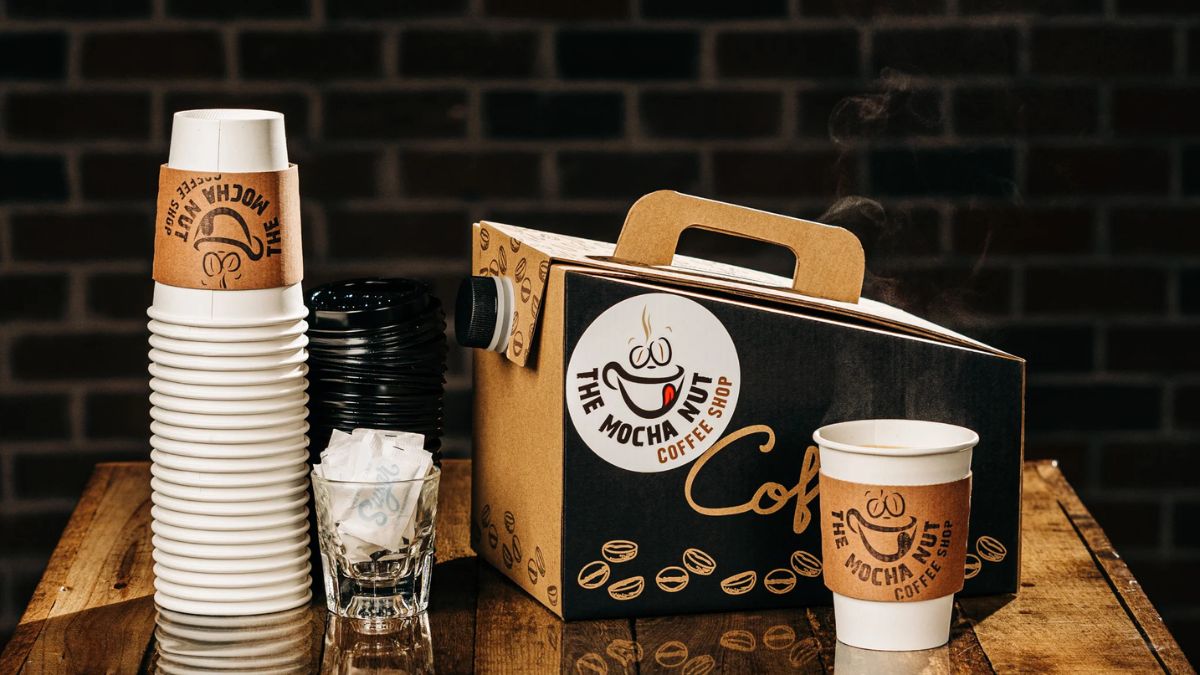FOOD
Eco-friendly Options: Sustainable Food Packaging for Companies

Traditional food packaging materials are harmful to the environment. Each day, hundreds of millions of over-packaged groceries and non-biodegradable plastic containers, straws, and cutlery are discarded around the globe.
However, an increasing number of companies and startups have come up with novel sustainable alternatives for food packaging materials, including plates made of cornstarch, popcorn kernels, and mushroom caps, biodegradable cutlery from agricultural waste such as avocado pits as well as corn-starch-based cutlery made into plates or trays for serving food.
Biodegradable
As consumer demand for sustainable packaging increases, companies shift towards eco-friendly alternatives. These new materials often come from renewable resources. They can be recycled through closed-loop systems for efficient recycling processes – not to mention that they help reduce carbon emissions and environmental impacts. Many people today want to support businesses that prioritize sustainability; many even willingly pay more for these products!
When selecting sustainable food packaging solutions, the primary factor should be material selection. It must be food-safe and non-toxic so as not to compromise the contents. Furthermore, biodegradability should also be prioritized; and materials sourced, manufactured, transported, and recycled using renewable energy sources must also be prioritized.
Biodegradable food packaging is an excellent option because it contains natural materials that can be composted into the soil for plant regrowth while helping reduce long-term waste in landfills. Biodegradable materials break down quickly while leaving no harmful toxins behind in the environment.
Recyclable
Sustainable food packaging is an approach that minimizes environmental impact throughout its design, production, shipping process, and disposal process. This goal can be accomplished by using recyclable and renewable materials and localizing supply chains; additionally limiting plastic usage; and employing right-size packaging – only using as much packaging as necessary to protect and preserve the product.
Food and beverage companies must work closely with suppliers and governments to reach their sustainability goals, including providing funding for recycling services and material recovery facilities as well as making changes in packaging design or incorporating recycled content. Companies like the one found at https://www.hdbiopak.com/ can help make this process easy. Such initiatives can help food and beverage firms move towards their net-zero targets more easily.
Alternative packaging materials that can be sustainably sourced and are more eco-friendly alternatives to polystyrene, glass, or metal are readily available and should be considered when making decisions about packaging materials.
Bioplastics from corn stalks or sugarcane, seaweed, and bamboo could provide options that are both recyclable and biodegradable – giving businesses and consumers alike more environmentally friendly options when it comes to selecting packaging material options. You can visit this helpful site to learn more.
Edible packaging is an innovative eco-friendly option. London marathon runners recently received edible drink pods made of milk protein and seaweed film that could be consumed if desired, yet will biodegrade within four to six weeks after disposal.

Compostable
Sustainable food packaging is composed of biodegradable materials that break down in the environment without harming it. This type of packaging often uses renewable resources such as cornstarch or sugarcane, or recycled materials like cardboard or glass that decompose naturally over time – helping reduce landfill waste while meeting consumer expectations for environmentally-friendly packaging.
Sustainable food packaging has many advantages, such as lowering carbon emissions and improving soil quality. Furthermore, this approach extends the shelf life of perishable food items while decreasing food waste – all while improving customer service levels and showing off your company’s concern for environmental impact.
Sustainable food packaging differs from its plastic counterpart in that it can be composted along with organic waste to produce nutrient-rich soil that can be used to grow future crops, while simultaneously helping the environment by lowering methane gas production and greenhouse gas emissions. You can click here to learn more about composting.
Many companies are adopting eco-friendly food packaging solutions. This can include reusable containers and cups that can be washed after each use, plates made of cornstarch or mushrooms as well as zero waste packaging solutions, which encourage consumers to bring in their containers from home, reducing unnecessary waste.
Reusable
Utilizing sustainable food packaging is an effective way to decrease plastic waste produced in your business while increasing customer satisfaction and improving your reputation. Furthermore, reusable packaging will save money by decreasing energy and materials consumption costs.
Conventional packaging may be ubiquitous, but companies are evolving towards more eco-friendly alternatives like bioplastics, compostable bags, and utensils made from agro-industrial waste as sustainable packaging options. You can visit https://en.wikipedia.org/wiki/Bioplastic to learn more about these products. Although such innovations represent great strides forward, more businesses and consumers need to embrace them for maximum impact.
Sustainable packaging definition involves the use of renewable resources like bioplastics or responsibly sourced paper. Furthermore, such packaging should be easily recyclable to promote a circular economy while being durable and reducing reliance on finite resources. Finally, consumers must easily recognize its sustainability characteristics so they can make informed choices.
Sustainable reusable packaging must be designed and produced so it can withstand repeated washing without degrading over time.
This will ensure its safety for both its user and environment despite repeated washes; furthermore, it should be free from toxic chemicals that might threaten human health or pollute the environment; finally, lightweight designs must be easy for everyday use, being lightweight enough for handling. This will help ensure a positive outcome for environmental efforts.
FOOD
Maximize Product Protection with High-Quality Tin Container

Tin packaging has a long history of acting as a protective barrier between products and environmental factors. And in all cases, protects the products from physical impacts as well. Tin packaging is known for protecting a huge variety of products, namely canned food tins, beverages, baby milk formulas, medicines, and many more.
For more details, have a look below at what kind of products can be stored inside tin packaging for maximum preservation and protection. Ultimately letting you choose tin packaging for ensuring safety of the produc’ts you want to store in it.
Food and Beverage
Canned food:
Tin packaging preserves the nutrients, taste, freshness and color of food items to a great extent. Tin packaging is made from Aluminum, a lightweight yet resilient material, that doesn’t let air, light, or moisture pass through, making the packaging air-tight. Which keeps the contained food items totally fresh as the time they were made.
The classic item that are packed in tin packaging are as follows:
- Vegetables
- Meat
- Fish
- Soups
- and even ready to eat meals
Beverages:
Tin packaging is used to preserve the quality and taste of beverages like soft drinks, beer, and juices.
Other food Items:
- Milk powder: As tin packaging prevents the seeping-in of air and moisture; the quality of milk powder stays intact.
- Chocolates and candies: The durable structure and protective barrier properties of tin packaging makes it ideal to preserve and keep fresh premium chocolates and candies.
- Dry goods: cancelling out the moisture and air, tin packaging is also ideal to store dried goods like coffee, tea, spices, and powder ingredients.
Cosmetics
The sturdy nature, and moisture resistant properties of tin packaging makes it ideal to house a variety of cosmetic items inside it. Especially those produc’ts that require a portable yet compact tin container. Some are listed below:
- Lip Balm: Due to its size and simple portability, the TIN packaging is perfect for lip balms.
- Soaps: Small soaps can be conveniently kept in tin boxes.
- Perfume: Tin Packaging offers stylish and protective containment for small perfume bottles.
- Nail Polish: tins protect your nail polish bottle from damage during transit.
- Eyeshadow Palette: The tin packaging perfectly provides a robust and compact way to save your eye makeup palettes.
Jewelry
Jewelries are prone to getting tarnished and blackened when they come in contact with moisture and oxidation. And tin packaging makes sure such ornaments don’t lose their luster and charm by preventing their interaction with moisture and air. You can customize tin packaging to complement and pack any jewelry item you want. Like:
- Necklaces
- Earrings
- Rings
- Bracelets
- Anklets
- Bangles
- And other small ornaments
Pharmaceuticals
Plenty of medical produc’ts can be packed into tin packaging to ensure protection against external factors.
- Herbal medicine: the airtight and light proof nature of tin packaging makes it idea to store and maintain the efficacy of herbal medicines.
- Powdered and Solid: tin packaging can also be used to package powder and solid dosage forms such as capsules and pills.
- Creams and Balms: Tin packaging is a traditional and effective way to pack these produc’ts, provide protection and easy extraction.
Toys and Stationery
Not only limited to protection from external elements, the high reusability of tin packaging makes it an ideal choice to pack toys and various stationery items. Like:
- Playing cards: Tin packaging box is a common and durable way to store and protect decks of playing cards, as well as poker sets.
- Toy parts: Tin Boxes can also store individual pieces of larger toys to ensure that they are organized and remain intact.
- Pens, pencils, and erasers: Tin Box provides a compact and organized opportunity to store a variety of writing utensils.
- Paper clips, safety pins, and office supplies: The moisture-resistant property of tin packaging helps protect these items from corrosion and damage.
- Cards and stamps: Tin packaging can be utilized to store and protect a variety of card and stamp sets.
Have a Look at The Key Protective Advantages of Tin Packaging
There are some things that make tin packaging the best choice for maximum produc’t protection. It’s essential barrier properties include:
- Airtight seal: This prevents air, moisture and oxygen from entering and affects the quality of the content.
- Light barrier: Tin packaging blocks UV light. This can cause rot and discoloration in some products.
- Corrosion resistance: Tin packaging is suitable for a variety of products, especially as it is opposed to corrosion resistance against acidic foods.
- Durability: Tin packaging is robust and can endure the difficulties in transport and storage.
Choose only the Best Tin Packaging Supplier for your Protective Tin Packaging needs
The aforementioned products can be protectively packed inside tin packaging to ensure their maximum safety. But knowing how tin packaging or what products it can safely hold is not enough even in the slightest. The tin packaging supplier garner essential importance in this aspect as well. For your complete ease of mind, we have sorted some of the best tin manufactures USA for you. All the suppliers in the list below have been shortlisted depending upon the freedom of customization, commitment to quality, and customer satisfaction they ensure.
- Tin Makers
- PakFactory
- TinWerks
- Timeless Tins Ltd.
- Atlantic Can
- Container and Packaging
- Ucan Packaging
- Tin King USA
Final Thoughts
If you’re ever in the search of packaging that offers unparalleled protection for your items, tin packages are the way to go. Whether you use them to pack foods items, cosmetic products, or volatiles, tin packaging ensures that the produc’t is protected and remains high quality.
However, choosing the right tin package supplier is also of the utmost importance. Our research shows that Tin Maker is one of the best tin manufacturer USA. It has really shaped the reason why Tin packaging remains a gold mine in the world of packaging.
FOOD
Creative Designs for Custom Plastic Cups

Custom plastic cups have transcended their traditional role as mere drinkware, evolving into dynamic tools for branding, celebration, and personal expression. Whether you’re orchestrating a grand event, promoting your business, or adding a personalized touch to your gatherings, these cups offer a canvas for creativity and functionality.
The Rise of Custom Plastic Cups
In today’s visually-driven world, presentation is paramount. Custom plastic cups serve as a unique medium to showcase your brand’s identity or event’s theme. From vibrant logos to intricate designs, these cups can be tailored to reflect your vision, leaving a lasting impression on your audience.
Exploring Design Possibilities
1. Logo and Branding Integration
Incorporating your company’s logo or event branding onto custom plastic cups can significantly enhance brand visibility. Whether it’s a minimalist design or a bold statement, these cups act as mobile advertisements, promoting your brand with every sip.
2. Themed Illustrations and Patterns
Tailoring cup designs to match specific themes or occasions adds a cohesive touch to your events. Be it tropical motifs for beach parties or elegant patterns for weddings, themed custom plastic cups elevate the overall aesthetic.
3. Personalization for Special Occasions
Personalized cups featuring names, dates, or special messages make events like birthdays, anniversaries, and weddings more memorable. They serve as cherished keepsakes for guests, commemorating the special day.
Benefits of Custom Disposable Cups
Custom disposable cups offer a blend of convenience and customization, making them ideal for various settings.
- Hygiene and Safety: Single-use cups reduce the risk of contamination, ensuring a safe experience for users.
- Time-Saving: Eliminates the need for washing, allowing for quick cleanup post-events.
- Versatility: Suitable for both hot and cold beverages, catering to diverse preferences
- Eco-Friendly Options: Many providers now offer biodegradable or recyclable custom disposable cups, aligning with environmental sustainability goals.
Design Tips for Maximum Impact
- Color Coordination: Choose colors that align with your brand or event theme to create a cohesive look.
- Readable Fonts: Ensure that any text on the cup is legible, opting for clear fonts and appropriate sizes.
- High-Quality Images: Use high-resolution images or logos to maintain clarity and professionalism.
Conclusion
Custom plastic and disposable cups are more than just beverage holders; they’re a reflection of your brand, event, or personal style. By thoughtfully designing these cups, you not only enhance the drinking experience but also leave a lasting impression on your audience. Whether for business promotions, special occasions, or personal gatherings, investing in custom cups is a creative and effective way to stand out.
FOOD
Coffee Catering: The Perfect Brew for Every Occasion

In recent years, coffee catering has emerged as one of the most sought-after additions to events ranging from weddings and corporate gatherings to festivals and private parties. More than just providing a caffeine fix, this service offers an immersive, personalised, and high-end beverage experience for guests of all kinds.
Whether it’s the scent of freshly ground beans wafting through the venue, the artistry of skilled baristas crafting beverages with precision, or the social charm of a portable espresso cart, coffee catering transforms an ordinary drink into a standout attraction.
The Rise of Speciality Coffee at Events
The modern guest has a refined palate and higher expectations when it comes to beverages. Gone are the days when standard brewed coffee in carafes was enough. Today, people expect freshly brewed espresso, cold brew on tap, and dairy-free options like oat or almond milk lattes. As a result, coffee catering has become a practical solution to meet these rising expectations.
Specialty coffee carts offer more than convenience—they create an atmosphere. Guests can interact with baristas, choose from a curated menu, and enjoy drinks made to order. This kind of service is particularly effective at elevating the guest experience and creating memorable moments.
What Is Coffee Catering?
At its core, coffee catering is the delivery of a complete mobile coffee setup to a chosen event venue. These setups can range from simple drip stations to full-service espresso bars that bring everything needed: coffee machines, grinders, syrups, milk alternatives, trained baristas, and even decorative carts or kiosks.
Depending on the provider, coffee catering may also include:
- Signature drink creation
- Custom cup branding
- Latte art
- Cold brew and nitro taps
- Pastries and snack pairings
It’s an all-in-one beverage solution that blends quality, creativity, and service.
Why Coffee Catering Makes Sense for All Events
There’s a reason so many event planners and hosts now consider coffee catering a must-have. It ticks all the boxes when it comes to enhancing the event atmosphere and providing thoughtful refreshments.
1. Versatility Across Event Types
From small business meetings to large weddings, a coffee bar can be scaled to suit any crowd. Some of the most popular events that benefit from this service include:
- Corporate conferences and meetings: Offer attendees an energy boost and a reason to network.
- Weddings: Delight guests with handcrafted beverages during the reception or cocktail hour.
- Private parties: Add sophistication and a social element to birthdays or anniversaries.
- Festivals and community events: Serve a crowd quickly with popular drinks that appeal to all ages.
2. Guest Engagement and Entertainment
Unlike traditional beverage setups, a coffee cart adds entertainment value. Watching skilled baristas craft each drink is not only enjoyable—it’s Instagram-worthy. It turns coffee into an interactive experience.
3. Customisation for Every Audience
Want a vegan mocha latte with oat milk? No problem. Need a sugar-free syrup? Done. Coffee catering providers often let hosts create personalised menus with a variety of drink options to meet all dietary and flavour preferences.
Planning a Coffee Catering Experience
Organising a successful coffee catering setup requires some planning, but the payoff is well worth it. Here are key factors to consider:
Determine Guest Count
Accurate estimates ensure the provider brings enough supplies and baristas. For large gatherings, consider multiple carts or extended service hours.
Choose Your Menu
Decide between a full espresso bar, a curated menu of two or three speciality drinks, or a wider range that includes teas, hot chocolate, and cold brews.
Venue Logistics
Make sure your location can accommodate the coffee setup. Some carts require access to power or water, while others are completely self-sufficient. Indoor or outdoor venues each come with unique considerations, such as flooring, weather protection, and foot traffic flow.
Time It Right
Coffee bars can be open for just a few hours or run throughout the entire event. Think about peak times when guests are likely to crave a beverage—typically during arrival, breaks, or after meals.
Selecting the Right Provider
Not all coffee caterers are created equal. Choosing the right one is essential for a smooth and successful experience. Look for providers with:
- Experience in handling events of your size and type
- Skilled baristas who are both efficient and personable
- Positive client testimonials or portfolio examples
- Clear service packages and pricing structures
A quality coffee service provider will handle everything from setup to cleanup, ensuring that you and your guests enjoy every sip without stress.
Coffee Catering vs. Traditional Beverage Stations
While beverage stations are common at events, they usually lack the freshness, customisation, and appeal of a mobile coffee cart. Here’s how coffee catering works. Coffee service through mobile carts offers a modern upgrade that guests appreciate and remember.
Costs and Value
The cost of coffee catering can vary widely depending on:
- Guest count
- Duration of service
- Drink complexity
- Equipment and staffing
- Travel and logistics
On average, basic coffee cart packages start at $500 for small events and scale up for larger, high-demand gatherings. While this might seem premium, the value in terms of guest satisfaction, branding, and ambience often outweighs the cost.
Add-Ons and Enhancements
Many coffee catering providers offer additional features that take the service to the next level:
- Custom Cups and Sleeves: Add your logo or event hashtag.
- Branded Menus: Tailored drink names that align with your theme.
- Latte Art Printers: Print images or text on foam for a wow factor.
- Pastries and Snacks: Pair drinks with croissants, biscotti, or muffins.
These extras turn an already special offering into a centrepiece of your event.
Sustainability in Coffee Catering
As more people become eco-conscious, many coffee catering providers are taking steps to operate sustainably. This includes:
- Compostable cups and lids
- Organic, fair-trade coffee beans
- Local sourcing of ingredients
- Reducing single-use plastics
- Environmentally friendly waste disposal
When booking your coffee caterer, it’s worth asking about their sustainability practices. A responsible coffee service provider in Denver will be transparent and enthusiastic about their efforts.
Trends in Coffee Catering
Just like the coffee shop industry, coffee catering evolves with trends. Here are some current favourites:
- Cold Brew and Nitro on Tap: A refreshing twist on traditional coffee, especially popular in summer.
- SpecialitSpecialityFeaturing ingredients like lavender, turmeric, or matcha.
- Vegan and Dairy-Free Menus: Growing demand for non-dairy milk and plant-based options.
- Seasonal Drink Menus: Pumpkin spice in the fall, peppermint mocha in the winter—timely and trendy.
- Interactive Coffee Stations: Let guests build ttheirdrinks or customise toppings and flavours.
These innovations keep coffee experiences fresh and relevant.
Final Thoughts
When it comes to creating a memorable and elevated event, coffee catering is more than a trend—it’s a modern staple. Whether for professional events or private celebrations, it delivers a delicious combination of luxury, personalisation, and guest engagement.
With so many customisation options and the ability to cater to diverse tastes and dietary needs, this service is a no-brainer for hosts who want to make a lasting impression. It not only satisfies cravings,but it also becomes a conversation starter and a focal point of your event.
As demand continues to grow, working with an experienced and reliable coffee service provider can ensure that every cup poured adds value, warmth, and style to your special day.
-

 TECHNOLOGY2 years ago
TECHNOLOGY2 years agoElevating Game Day Eats: A Guide to Crafting Crowd-Pleasing Sliders
-

 ENTERTAINMENT2 years ago
ENTERTAINMENT2 years agowave_of_happy_: Your Ultimate Guide
-

 FASHION2 years ago
FASHION2 years agoGPMsign Fashion: Redefining Style with Purpose
-

 TECHNOLOGY1 year ago
TECHNOLOGY1 year agoTrader Joe’s Dayforce: Revolutionizing Workforce Management
-

 FOOD2 years ago
FOOD2 years agoAltador Cup Food Court Background: A Culinary Extravaganza Unveiled
-

 HOME IMPROVEMENT1 year ago
HOME IMPROVEMENT1 year agoWhat Kitchen Renovation Companies Offer Beyond Basic Remodeling
-

 SPORTS2 years ago
SPORTS2 years agoScore Chaser Sporting Clays: A Thrilling Pursuit of Precision
-

 NEWS2 years ago
NEWS2 years agoNyl2 Kemono: Unveiling the World
